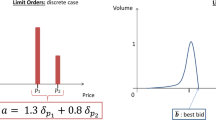Abstract
We study Merton’s portfolio optimization problem in a limit order market. An investor trading in a limit order market has the choice between market orders that allow immediate transactions and limit orders that trade at more favorable prices but are executed only when another market participant places a corresponding market order. Assuming Poisson arrivals of market orders from other traders we use a shadow price approach, similar to Kallsen and Muhle-Karbe (Ann Appl Probab, forthcoming) for models with proportional transaction costs, to show that the optimal strategy consists of using market orders to keep the proportion of wealth invested in the risky asset within certain boundaries, similar to the result for proportional transaction costs, while within these boundaries limit orders are used to profit from the bid–ask spread. Although the given best-bid and best-ask price processes are geometric Brownian motions the resulting shadow price process possesses jumps.
Similar content being viewed by others
References
Davis M., Norman A.: Portfolio selection with transaction costs. Math. Oper. Res. 15, 676–713 (1990)
Foucault T., Kadan O., Kandel E.: Limit order book as a market for liquidity. Rev. Financ. Stud. 18, 1171–1217 (2005)
Galtchouk L.I.: Stochastic integrals with respect to optional semimartingales and random measures. Theory Probab. Appl. 29(1), 93–108 (1985)
Goll T., Kallsen J.: Optimal portfolios for logarithmic utility. Stoch. Process. Appl. 89, 31–48 (2000)
Harris L.: Optimal dynamic order submission strategies in some stylized trading problems. Financ. Mark. Inst. Instrum. 7, 1–76 (1998)
Hartman P.: Ordinary Differential Equations. Wiley, New York (1964)
Jacod J., Shiryaev A.N.: Limit Theorems for Stochastic Processes, 2nd edn. Springer, Berlin (2002)
Jarrow R., Protter P.: Large traders, hidden arbitrage, and complete markets. J. Bank. Financ. 29, 2803–2820 (2005)
Kallsen, J., Muhle-Karbe, J.: On using shadow prices in portfolio optimization with transaction costs. Ann. Appl. Probab. (forthcoming)
Karatzas I., Shreve S.E.: Methods of Mathematical Finance. Springer, Berlin (1998)
Korn R.: Optimal Portfolios: Stochastic Models for Optimal Investment and Risk Management in Continuous Time. World Scientific, Singapore (1997)
Kühn C., Stroh M.: A note on stochastic integration with respect to optional semimartingales. Electron. Commun. Probab. 14, 192–201 (2009)
Matsumoto K.: Optimal portfolio of low liquid assets with a log-utility function. Financ. Stoch. 10, 121–145 (2006)
Menaldi J., Robin M.: Reflected diffusion processes with jumps. Ann. Probab. 13(2), 319–341 (1985)
Merton R.: Lifetime portfolio selection under uncertainty: The continuous-time case. Rev. Econ. Stat. 51, 247–257 (1969)
Merton R.: Optimum consumption and portfolio rules in a continuous-time model. J. Econ. Theory 3, 373–413 (1971)
Parlour C.A., Seppi D.J.: Limit order markets: a survey. In: Thakor, A.V., Boot, A.W.A. (eds) Handbook of Financial Intermediation and Banking, pp. 63–96. North-Holland, Amsterdam (2008)
Pham H., Tankov P.: A model of optimal consumption under liquidity risk with random trading times. Math. Financ. 18, 613–627 (2008)
Protter P.E.: Stochastic Integration and Differential Equations, 2nd edn. Springer, Berlin (2004)
Rogers L.C.G., Zane O.: A simple model of liquidity effects. In: Sandmann, K., Schönbucher, P.J. (eds) Advances in Finance and Stochastics: Essays in Honour of Dieter Sondermann, pp. 161–176. Springer, Berlin (2002)
Roşu I.: A dynamic model of the limit order book. Rev. Financ. Stud. 22(11), 4601–4641 (2009)
Shreve S.E., Soner H.M.: Optimal investment and consumption with transaction costs. Ann. Appl. Probab. 4(3), 609–692 (1994)
Author information
Authors and Affiliations
Corresponding author
Rights and permissions
About this article
Cite this article
Kühn, C., Stroh, M. Optimal portfolios of a small investor in a limit order market: a shadow price approach. Math Finan Econ 3, 45–72 (2010). https://doi.org/10.1007/s11579-010-0027-9
Received:
Accepted:
Published:
Issue Date:
DOI: https://doi.org/10.1007/s11579-010-0027-9




